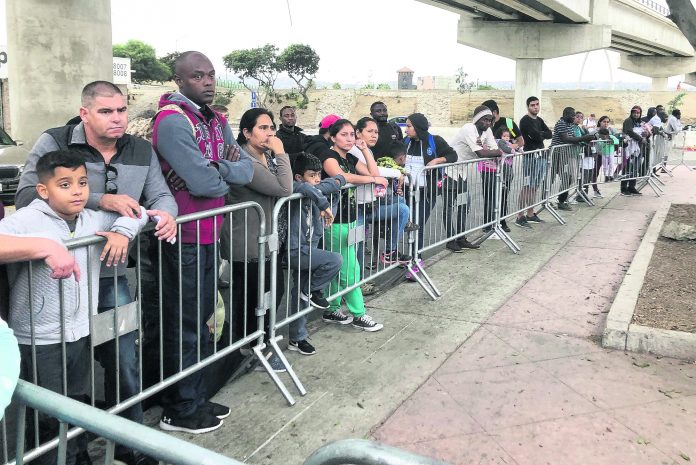
A Peruvian family that waited for six months at the Mexican border finally got their chance to make their case for U.S. asylum Thursday. But because they waited there as officials recommended, they face a new reality: Anyone who traveled through a third country and is seeking asylum after July 16 will be denied.
If they had sneaked in illegally when they arrived in Tijuana, they would have escaped the Trump administration’s partial asylum ban.
“The family wanted to do it the way it’s supposed to be done,” said Luz Bertila Zazueta, 75, who arranged free lodging for them and joined neighbors in ensuring they had enough food.
The Southern Poverty Law Center and other advocacy groups asked a judge Thursday to prohibit the government from applying the new restrictions to anyone who appeared at an official border crossing to claim asylum before the policy was announced on July 16.
The government played “bait and switch” by instructing migrants to wait in Mexico for an opportunity to apply for asylum before imposing sharp restrictions on their eligibility, attorneys said in a court filing.
It is difficult to know how many people fall into that category, but the groups estimate that 26,000 people are on waiting lists in Mexican border cities to make an initial claim for U.S. asylum. The Associated Press counted 19,000 in just four cities in late July, including 10,000 in Tijuana alone.
The Justice Department declined to comment on the court filing, which is part of a lawsuit addressing two key practices that have left would-be asylum seekers frustrated and deflated.
One, known officially as “metering,” has sharply limited the number of asylum seekers accepted each day at U.S.-Mexico border crossings since spring 2018. The administration says the policy is in place because of capacity constraints.
The other is the policy that took effect Sept. 12 to deny asylum to anyone who reached the U.S. after traveling through another country and failing to seek asylum there.
U.S. officials have repeatedly said the right way to seek asylum is to request it at border crossings, instead of entering illegally. That has caused tens of thousands of migrants to wait in often-dangerous Mexican border cities under an opaque, haphazard system of waiting lists that vary sharply by city.
Lists are managed by Mexican immigration authorities, local or state authorities, migrant shelters or migrants themselves, depending on the city.
The asylum ban applies to people who entered the U.S. on or after July 16 — no matter how they crossed the border — including people who arrived before that date and decided to wait in Mexico as instructed by U.S. authorities.
“The government cannot pull such an immoral bait and switch,” according to the filing by the Southern Poverty Law Center, Center for Constitutional Rights and American Immigration Council.
It seeks immediate action to “remedy the combined effect of these policies in a single stroke.”
It is part of a long-running lawsuit in federal court in San Diego on behalf of Los Angeles-based advocacy group Al Otro Lado that asserts metering denies people the right to seek asylum under U.S. and international law. The judge has yet to rule on the case.
“This is not the DMV. This is not the deli counter. There shouldn’t be numbers,” said Melissa Crow, an attorney for the Southern Poverty Law Center.
U.S. authorities have insisted that they are respecting people’s rights to seek asylum.
“It’s not turning people away, it’s asking them to wait,” Kevin McAleenan, acting Homeland Security secretary, told reporters in October 2018, when he was Customs and Border Protection commissioner.
The court challenge comes amid a string of legal and political victories on one of President Donald Trump’s signature issues as he seeks re-election: immigration.
His administration on Wednesday reached agreement with Honduras that paves the way for asylum seekers who traveled through the violent Central American country to be sent back there to ask for protection if they reach the U.S.
It mirrors similar pacts with El Salvador and Guatemala, effectively creating a blockade for asylum seekers who travel through Central America’s “Northern Triangle” on the way to the U.S. border.
Border Patrol arrests reached a 13-year monthly high in May, many of them Central American families who traveled across Mexico and entered the U.S. illegally to seek asylum.q



















